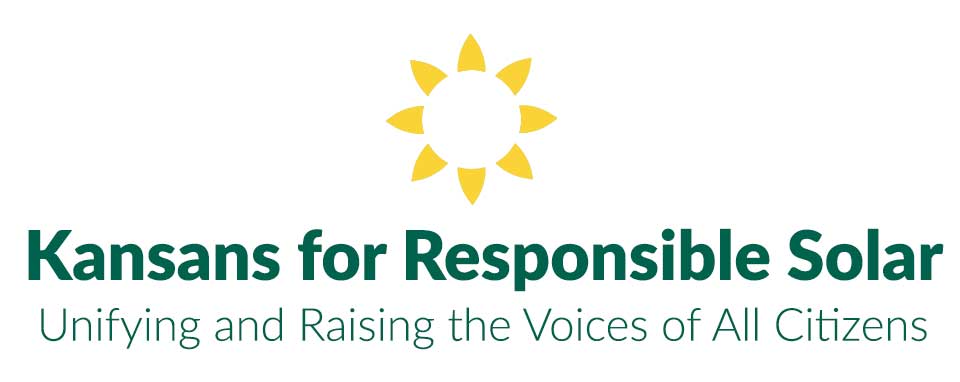BIG CONCERNS IN KANSAS
Protect Kansas Counties from IRRESPONSIBLY SITED Industrial Utility-Scale Solar Facilites
Kansas Citizens Take Action, Raise Your Voices…NOW
Our rural neighborhoods and communities are being besieged by energy companies who are aggressively securing as much agriculturally zoned land as they can in our counties to build large, utility-scale, industrial solar facilities.
Why in our rural communities?
Because its cheaper for energy companies to use our rich agriculturally zoned land to take advantage of lower development costs.
It is critical to get involved NOW if you want to preserve your Kansas quality of life,
our beautiful rural land, communities and wildlife habitats.
SUPPORT the Federal Lawsuit Against IRA Tax Subsidized
Industrial Utility-Scale Solar Power Facility Projects
that Have Not Undergone NEPA Review
Concerns Grow Over Utility-Scale Solar Power Facilities Expanding Across Rural America
Fox News Bret Baier and Mike Emanuel Report on the Citizen Opposition to NextEra Energy’s West Gardner Solar Project
Fox News chief Washington correspondent Mike Emanuel has the latest on the growing pushback in America’s heartland against solar power and its expansion on ‘Special Report.’ May 18, 2023 https://www.foxnews.com/video/6327787008112
Concerned Citizens’ Testimonies
KS Legislature Committee on Utilities Citizens 3/16/2022 Presentation
Soil Errosion & Ecosystem Risks
Roger Boyd Ph.D. – Douglas County, KS Santa Fe Trail Association
Ask Questions, Knowledge is Power
KS Senator Mike Thompson – The Truth About Renewable Energy
The Real Cost of Renewables
Mark Mills/PragerU – What’s the Real Cost of Renewables?
Negative Economic Impacts
Risks of Soil & Water Contamination
Negative Impacts to Agribusiness
John & Millie Franke – Owners GLO Farm and Frankenbees
The Negative Long Term Impacts
KS Senator Mike Thompson – The Long-term Impacts
A Simpler Solution for Climate Change
Kiss the Ground Documentary – A simple solution for climate change
Property Devaluation
Lack of Transparency by Developers & Local Government
History & Communities at Risk
Barbara Kerr – KU Professor & Douglas County, KS Resident
The Unknowns of Decommissioning
KS Senator Mike Thompson – Decomissioning Utility-Scale Solar
Soil & Water Contamination
Damaged Solar Panels = Soil & Water Contamination Concerns
Help Your County Planning Commission and Commissioners Craft STRONG Solar Regulations…No Regrets!
For Kansas County Elected Officials to protect their residents, STRONG SOLAR REGULATIONS are critial legislation. Regulations that clearly and consistently outline the provisions that are required by our counties to be included in all Utility-Scale Solar project proposals submitted by all energy companies.
Energy and Utility companies in general make a lot of promises when it comes to Utility-Scale Solar: increased revenue, jobs, little to no impact on the environment and property values. Solar Regulations that clearly define the provisions of a developer’s obligations will protect and preserve Kansas quality of life, our agricultural heritage, the character of our counties and our environment.
Protecting Agricultural Land, Wetlands & Waterways
Preserving Historical Sites
Limiting Utility-Scale Solar Facility Size
and distance between projects.
Solar Facility Setbacks and Buffers
In order to protect adjacent landowners and protect the rural character of our communities, regulations must include generous, clearly defined setbacks and landscape buffers.
Decommissioning Regulations to Protect Counties and Taxpayers
Utiltiy-Scale Solar Developers will try to ignore and/or downplay decommissioning.
Decommissioning massive solar projects is a very important issue for our counties. Developers will try to claim that the net salvage value of their “dead” Solar Facility will exceed the cost of decommissioning.
Utiltiy-Scale Solar Developers usually sell their interest in their Solar Plant after 2 – 3 years of operation. This means that they will be long-gone by the time decommissioning comes around
Did you know? Ownership of Utiltiy-Scale Solar Facilities turns over many times during the life of a system.
Most solar developers/operators are LLCs. They can walk away from their Solar Projects whenever they want to.
